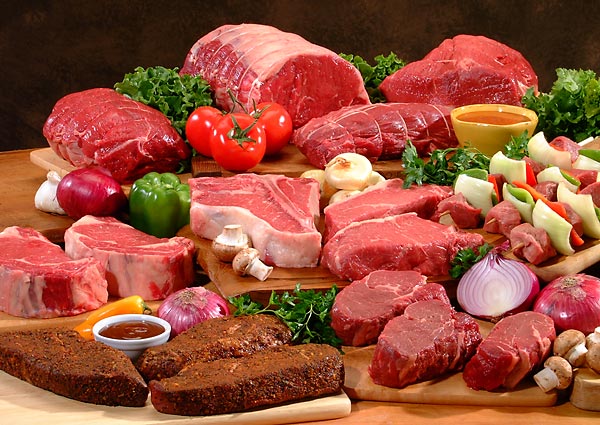
Beef Buzz News
Food Safety Takes a Concerted Effort from Producers All the Way to Consumers
Fri, 19 Apr 2013 16:19:10 CDT

Safety is always near the top of concerns consumers have about their food. Publicity in the media can often make small, local problems seem much larger than they really are, and consumers can easily be misled into thinking danger lurks where, in fact, none does.
But, says Dr. John Ruby, that doesn't mean that food producers shouldn't be constantly seeking to make their products evermore safe. Ruby is the Vice President of Technical Services for JBS USA Beef Division. He oversees the Food Safety, Quality, and Animal Welfare departments. He has worked for JBS for 13 years in a variety of food-safety roles.
His research at the University of Wisconsin-Madison focused on Beef Processing Microbial Intervention Systems and the reduction of e coli and multi drug-resistant salmonella, so he is intimately concerned with how producers can make their products more safe.
Radio Oklahoma Network Farm Director Ron Hays spoke with Ruby at the recently-completed National Institute of Animal Agriculture's annual conference. He says food safety is everyone's business from the producer all the way through the consumer. He says a tremendous amount of that responsibility, however, does indeed lay with producers.
"So, like I said in my presentation: As a general rule of thumb, if you're making money selling product that eventually somebody is going to eat, you have a responsibility in food safety. Whether you are producing an animal-and I've heard the term 'well, it's not food yet'-eventually it's going to get to be food. As a packer, we owe that responsibility of making sure if we produce it to get it to the further processor. I've heard further processors will say, 'Well, I bought this, it's got the mark of inspection,' but at the end of the day, we all have the responsibility of making sure that product is as safe as it can get going through every segment of that food chain."
Making food that is as safe as it can be and constantly improving, constantly staying ahead of bacteria that are constantly mutating, comes at a price, Ruby says.
"It is something that is going to be an incurred cost. I'm not implying it's going to be free. But, in order to get to the new technologies and the systems that are effective in reducing these organisms-the bugs are getting smarter every day-we need to get smarter with them. The investigation into these systems is not going to be a free process, but I think we need to invest the time and the effort into it and we need to invest the dollars as well."
Ruby says keeping food safe, especially meats, is a difficult task because animals can harbor pathogens both externally and internally. And, he says, that level of diffulty increases when you begin dressing animals.
"There are three truths, basically, when you dress an animal: You're going to transfer some sort of microorganism to the surface of that carcass. It can't be avoided. Therefore you need a mechanical intervention system that's going to decontaminate that when you get it on there. However, you cannot create a mechanical intervention system that's strong enough to overcome a poor dress job. You can't expect that you're just going to rip that hide off, get whatever you want out of the carcass and then run it through some lactic acid because it's not going to happen.
"You've got to have both: You've got to have a good dress and you've got to have a good mechanical intervention system. Because it's not really the internals, it's really the outside and transferring the bugs from the hide onto the carcass through the dressing procedure. So, once you figure out how to correct that process, then you're going to be in much better shape."
Ruby says that there are about 300 million American consumers who are expecting the livestock industry especially to not only feed them, but to keep them safe.
"Take beef, for example. Beef is a center-plate item. We owe it to our customers to provide them products they can feel safe in purchasing. Is there a responsibility for the consumer? Yes, you're buying a raw product, but at the end of the day, they need to feel safe that they can go into a store and buy a package of meat that they can take home to their families, cook it on the grill and enjoy it without the risk of becoming ill."
Getting information out to the consumer to let them know just how seriously the meat industry takes this responsibility for providing safe products is a very difficult task, Ruby says.
"From the packer's standpoint, it's really challenging to get to the consumer, because we're a step away from or two degrees past, because it goes through our retailers and then to consumers. I think a lot of the education should really come from retailers. Also, it should come from the USDA. I think part of their responsibility is to educate consumers on what is the process and the products that they are getting. I think if they were to do a better job at that, you'd have better-informed consumers and a better-informed consumer is going to mean less food-borne illnesses out in the market."
The Beef Buzz is a regular feature heard on radio stations around the region on the Radio Oklahoma Network- but is also a regular audio feature found on this website as well. Click on the LISTEN BAR below for today's show- and check out our archives for older Beef Buzz shows covering the gamut of the beef cattle industry today.
WebReadyTM Powered by WireReady® NSI
Beef News



















